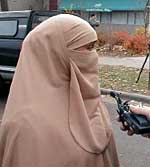By Art Hughes
Minnesota Public Radio
September 25, 2002
Rankings by the U.S. Census Bureau show members of some immigrant groups in Minnesota remain mired in poverty. While all minorities improved economically during the 1990s, Minnesota has one of the highest percentages of Asians in poverty when compared to other states. The ranking also confirms the widely-held belief that there are more Somalis in Minnesota than anywhere else in the U.S.
| |
|
|
|
||
Minnesota's prosperity in the 1990s pushed the state up the ladder of economic success compared to the rest of the country, and the state's Asian population shared in the wealth. But the rise in median income since the 1990 census only tells a part of the story.
The ranking for poverty shows a gap in progress for those Minnesotans in the general racial category, Asians. The state is seventh-highest in the country for the percent of Asians living in poverty.
Ilean Her is director for the State Council on Asian Pacific Minnesotans. She says many Asians in Minnesota are onto their second or third generation and are highly professional and well off. Others, however, are not far removed from problems in their country of origin and are still having a difficult time adjusting.
"You've got refugees or community members with refugee experience coming into Minnesota, and making up more than 50 percent of the Asian Pacific population in Minnesota," Her said. "And that's the group that, I believe, has issues with poverty, and needing more time to work and decrease the income gap."
Her's perspective is backed up by Will Craig, associate director for the Center for Urban and Regional Affairs at the University of Minnesota. He says Minnesota has a high percentage of Southeast Asians who lost bread-winning male family members in the war.
"What we're looking for and hoping for is that the Hmong, the Cambodian, the Laotian, the later refugees out of Southeast Asia would be able to get on the economic escalator and rise -- just as many of our ancestors did -- and take advantage of economic opportunity in Minnesota," Craig said. "The median income figure shows that, in fact, that's happened for quite a few people. But clearly there are people who've been left behind."
The median income for Asians in Minnesota was second only to the white majority population, and home values for Asians exceeded those for whites. The census ranking shows Minnesota is mostly in the middle compared to other states when it comes to incomes, home values and other economic indicators for blacks, Hispanics, American Indians and other minorities.
David Birkholz with the state demographer's office says time typically evens out the highs and lows of income for a particular group.
"The assumption would be -- and there has been shown some experience in being so -- that as the population is here a more extended period of time, the incomes will catch up eventually to the other Asian populations," said Birkholz.
For Minnesota's white residents, the poverty rate is in the bottom five states. Only 6 percent are below the federal definition of poverty.
Minnesota did top one category in the census ranking.
Now that all the ancestry numbers for all the states are calculated, Minnesota can officially claim the largest Somali population in the country. About 11,200 Somalis call Minnesota home, which is more than three times the next highest population of 3,600 in California. Georgia is third, with about 3,400 Somalis.
Minnesota also has three of the top five cities in terms of Somali numbers. Minneapolis is first, Columbus, Ohio is second. Rochester and St. Paul are four and five respectively.
More from MPRMore Information

